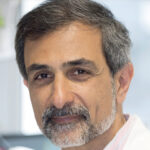Link to Pubmed [PMID] – 17287398
Mol. Biol. Cell 2007 Apr;18(4):1397-409
Genetically engineered mice (Myf5nLacZ/+, Myf5GFP-P/+) allowing direct muscle satellite cell (SC) visualization indicate that, in addition to being located beneath myofiber basal laminae, SCs are strikingly close to capillaries. After GFP(+) bone marrow transplantation, blood-borne cells occupying SC niches previously depleted by irradiation were similarly detected near vessels, thereby corroborating the anatomical stability of juxtavascular SC niches. Bromodeoxyuridine pulse-chase experiments also localize quiescent and less quiescent SCs near vessels. SCs, and to a lesser extent myonuclei, were nonrandomly associated with capillaries in humans. Significantly, they were correlated with capillarization of myofibers, regardless to their type, in normal muscle. They also varied in paradigmatic physiological and pathological situations associated with variations of capillary density, including amyopathic dermatomyositis, a unique condition in which muscle capillary loss occurs without myofiber damage, and in athletes in whom capillaries increase in number. Endothelial cell (EC) cultures specifically enhanced SC growth, through IGF-1, HGF, bFGF, PDGF-BB, and VEGF, and, accordingly, cycling SCs remained mainly juxtavascular. Conversely, differentiating myogenic cells were both proangiogenic in vitro and spatiotemporally associated with neoangiogenesis in muscular dystrophy. Thus, SCs are largely juxtavascular and reciprocally interact with ECs during differentiation to support angio-myogenesis.

